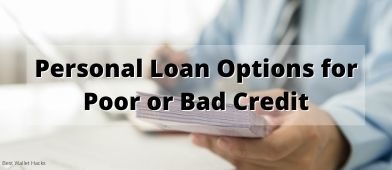Personal loans are one of the least talked about subjects in personal finance.
It’s tricky because it combines two of the stickier areas of life – debt and relationships.
One of our friends went back to graduate school with the help of a loan from his in-laws. It was like a loan from the bank except it had favorable terms (interest was really low), far better than what a bank would’ve offered on a personal loan! They drew up a note, had a spreadsheet tracking the payments, and as far as I know, it has worked out.
But sometimes personal loans run into problems. We all know about the classic question of whether you should lend money to your friends or relatives. The answer is usually “lend only what you’re willing to lose!”
Still, personal loans can be a great way to save money.
Table of Contents
What is a Personal Loan?
A personal loan is a loan that isn’t secured by any tangible assets. Car loans and mortgages are secured by the underlying assets, such as the car or the house. If you can’t make payments and default on the loan, the bank can foreclose on the asset and sell it at an auction to recoup its money.
You can get personal loans from banks, credit unions, and even friends and family. Not all banks offer personal loans. For example, Bank of America, one of the largest banks in America, does not offer a personal loan.
In general, the loans are two to five years in length and have an interest rate that varies widely based on your credit risk. SoFi, best known for student loan refinancing and SoFi Money, advertises rates of 5.99% to 16.19% APR (July 13th, 2020). I’ve seen personal loan rates in the 30-40% range, usually for folks who are very risky.
Finally, personal loans also come with fees. These origination fees can be from 0% (free) to 5-6%.
On Personal Loans to Family Members
If you get a personal loan from an individual, such as a family member, the rules start to change a little. Let’s talk about it from the perspective of the person lending money because when you loan money to someone taxes start becoming an issue.
When you lend money, you need to set a high enough interest rate to avoid below-market rates. Below market means your interest rate is zero or a rate below what’s known as the applicable federal rate, or AFR. AFR is set by the government and published by the IRS each month.
Loans can be short term (term of 3 years or less), mid-term (3 – 9 years), and long-term (more than 9 years) and the interest rate changes based on the term. The AFR may change each month, but when you create the loan, the interest rate on that loan can be fixed to whatever the AFR was at the time.
The reason for creating a written note and charging interest is to ensure it’s not considered a gift. The loan note should show the interest rate, payment schedule, and any collateral. If you don’t and are audited, the IRS will probably consider it a gift, and gifts are covered by the gift tax. Another reason for creating a note is if the borrower defaults, you can claim it as a non-business bad debt deduction. Those are short term capital losses.
If you are going to lend money (or borrow from a family member), make sure you understand these rules fully to avoid any tax headaches.
Should You Take Out a Personal Loan?
The big question is: “Why do you need a personal loan?”
There are typically two reasons why you would want to get a personal loan:
- Purchase something expensive
- Pay off debt (which is essentially paying for what you previously purchased)
The question then is whether a personal loan is the right type of loan.
For that, you need to ask yourself:
Can It Save You Money?
Paying off debt, especially credit card debt, is difficult because it has a high-interest rate. When you’re paying 18-20% interest, your payments are only going to cover so much of the principal. If you’re not paying down principal, you’re only paying interest which gets added each statement period!
Many people use personal loans to consolidate high-interest rate debt (like credit card debt) because personal loans can often have lower interest rates. This lower interest rate has a trade-off. Personal loans are only for two to five years, whereas credit cards will let you carry that debt indefinitely. Credit cards typically set the minimum payment at 2-5% of the balance, and as long as you make minimum payments, they’ll keep lending you money up to your credit limit.
If you aren’t committed, you’ll put yourself in a much tighter position because the terms are so short.
Is It the Cheapest Option?
A personal loan can be a good option for paying down credit card debt, but it might not be the best available option for other things.
For example, you could get a personal loan to pay for a home remodel. If you have home equity, you could get a home equity loan or open a home equity line of credit. A home equity loan can be anywhere from five to thirty years with interest rates that are variable or fixed.
A home equity loan can offer better rates and longer terms because they are secured by your home. Much like a mortgage, if you default on the loan, the bank can foreclose on your home.
Like other loans, you may have to pay fees on home equity loans. It’s not uncommon for banks to offer home equity loans without high fees or closing costs to try to win your business. If you are considering a home equity line of credit, they can often be opened with just a small fee.
Alternatively, a personal loan may not be the cheapest option for an unsecured loan. It all depends on your situation.
For example, there are many credit cards that offer 0% balance transfers. If you only need the funds for a short period, 12-18 months, it may be better to get a balance transfer (even after the balance transfer fee which is usually 1-3%). You get 0% interest compared to the 6%-20% APR of a personal loan, plus the credit card application process is much faster.
This only works if you can pay back the entire balance transfer in full by the end of the promotional period. Otherwise, you’ve just saddled yourself with high-interest debt!
Can It Increase Your Income?
My friend borrowed money from his in-laws at a lower rate than what he’d pay in student loans, even after the tax benefits. This enabled him to get a degree that significantly increased his earning power, which he would bring to bear on that loan.
In his case, he got a loan from a private person and not a bank. It would’ve been difficult for him to get a 5-year loan to pay for a two-year graduate program (or more realistically, two 5-year loans – one for each year). Once you get the loan, you have to start making payments. While it would’ve been possible, it would’ve been difficult to make those payments without significant income.
What If It’s Just For Fun?
Did you know that there is such a thing as a vacation loan? Since personal loans are unsecured, many banks don’t care what you use your loans to buy. So, there are situations where people get a personal loan to help pay for a vacation – they’re named vacation loans!
Since they have a name, it’s best to search for vacation loans rather than personal loans and they have similar terms. The loans are generally $1,000 to $2,000 with interest rates based on your credit score. Many lenders will need you to have a pretty good credit score.
In a perfect world, you’d save up for a vacation and then get a travel credit card with a big-spending bonus. But in the real world, a vacation loan isn’t better than savings; however, it’s a lot better than going into credit card debt to pay for a vacation.
Where to Find a Personal Loan
Your best option is to find family and friends who are willing to lend you money at the applicable federal rates. At the time of this writing, the AFR for February 2020, annual compounding, was:
- Short term – 1.59% APR
- Mid-term – 1.75% APR
- Long term – 2.15% APR
The lowest rate I’d seen anywhere else was above 5%. (one other thing to consider is how fast you can get a personal loan, not every lender can get you a loan as quickly as you need one)
Monevo
Monevo is a personal loan marketplace that you can use to find the best rates from over 30 lenders and banks. Shopping around with lenders can often get you better rates than going with a single lender directly, since you can see what folks are offering.
The loans can be used for anything from home improvements to student loan refinancing.
SoFi

SoFi stands for Social Finance and they started as a student loan refinancing company. They’ve since added several other services including a banking and personal loan product.
With SoFi loans, you can get a 2-7 year loan with fixed rates ranging from 5.99% APR to 18.38% APR (with AutoPay). There are no fees, and you can get as little as $5,000 to as much $100,000.
Fiona
If you don’t like what you see from those two lenders, or you want to check multiple loans at once, I’d use a resource like Fiona to help find the best personal loan option for my situation.
They work with a variety of lenders to find a loan anywhere from $1,000 to $100,000 with loan terms ranging from 24 to 84 months. The best part is that checking the rates will not affect your credit score and you will see actual rates before you apply. The rates start at 4.99% APR.
It takes just a few minutes to find out what your options are, and it can be a great way to get funding for whatever you need.





